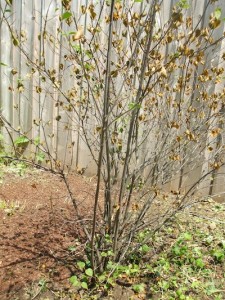
Indiana lawns, trees, shrubs and other plants are suffering in the drought. (C) Jo Ellen Meyers Sharp
This article ran a few years ago, but the info is still good. It helps you decide priorities when it comes to caring for plants in the landscape. — jems
Whew! It’s hot. Most of Indiana is in a drought. The provisos have been in the newspaper, on television and radio. Still, people water their lawn to make sure their green velvet landscape retains its curb appeal.
Drought conditions do bring Indiana gardening priorities into play, including which plants we want to protect.
Take the lawn, for instance. Grass seed or sod is cheap compared to a tree or shrub. Grass is cheap compared to perennials and annuals, too. What makes grass valuable is all the maintenance to keep it green, mowed and weed free.
In the world of plant priorities, drought and water requirements, here’s a recommended order:
1. Newly planted trees, shrubs and perennials. It is critical to these plants’ overall health, vigor and long-term survival that they get at least an inch of rain or supplemental water every week or 10 days. Water newly planted stock at least the first year, preferably the first three years.
2. Vegetables and fruit need regular watering for the best production. Irregular watering may contribute to blossom end rot in tomatoes and some other vegetables. Vegetables and fruits need about an inch of water every week or 10 days.
3. Annuals and other plants in containers usually need to be watered every day or every other day. The larger the container, the less you may have to water. Water the annuals in the ground, too. This can be done every week or 10 days.
4. Established perennials (three years or more in the ground) can be kept flowering with a good drink of water every two weeks. Many established perennials will survive a drought without any supplemental water, but flowers will be greatly reduced. Native plants are particularly well suited to environmental challenges.
5. Established shrubs or trees (three years or more in the ground) can be watered deeply about once a month, especially if they are showing signs of stress.
6. Believe it or not, established lawns can withstand several weeks of drought without thinning or death. The length of time varies according to the overall health of the lawn, soil, amount of fertilizer, foot traffic and other factors. Application of about one-half inch of water every two to three weeks will keep the crowns of grass alive, but won’t likely green it up.
Avoid fertilizing plants during drought or when reducing water. When watering, a showerhead nozzle placed at the base of plants is efficient at getting the water where it’s needed. Water the soil, not the plants.
A few gardeners use “gray water” on ornamental plants during drought. Many gardeners, especially those in water restricted areas in the country, rely on gray water all the time.
Gray water is “used” water collected from baths, showers and other kinds of household activities. There is some controversy about using gray water, especially from dishwashing and the laundry because of the potential of contaminates, such as detergent salts, grease or fecal material. Its use is illegal in some states, but not in Indiana.
However, sticking a bucket in the tub when you take a shower or dipping it in the bath water should not be hazardous when poured on ornamental plants. Avoid water that has been softened or which contains a lot of soaps or detergents because they can add salts to the soil, eventually causing plant damage. Most experts say gray water should not be used on vegetables or on plants in containers.
Rosie Lerner, consumer horticulturist at Purdue University, also has some tips for dealing with drought in the landscape, including an advisory that stressed plants may show the effects next season.
“Keep in mind that next year’s growth will be determined by buds that form this summer and early fall. Flower buds for spring flowering and fruiting plants will also be developing during this time,” Lerner says. “The damaged inflicted by drought now may affect next season.”

Even mature shrubs are showing signs of stress from the Indiana drought. (C) Jo Ellen Meyers Sharp
Leaf scorch on trees and shrubs, appearing as a browning along the edges of the leaves, is very common in dry summers. While minor cases of leaf scorch are not very harmful, prolonged lack of moisture can spell disaster for landscape plants. “Young and newly established plants are most susceptible to the dry conditions, but even established plants may reach a critical point during prolonged drought. Branch die back, combined with eventual root death, will make plants more susceptible to winter injury. Plants that were already under stress from other factors may succumb to severely dry soils,” Lerner says.